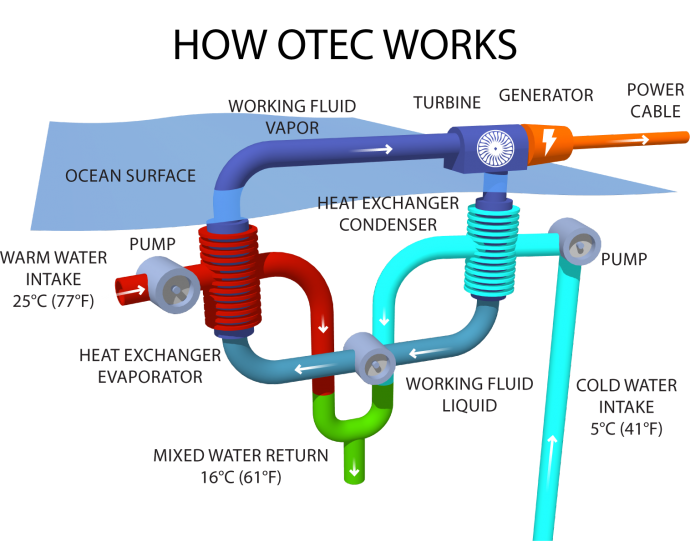Ocean Thermal Energy Conversion (OTEC): Unlocking the Power of the Ocean
Introduction:
As the world grapples with the urgent need to transition to sustainable energy sources, innovative technologies are emerging as potential solutions. One such promising technology is Ocean Thermal Energy Conversion (OTEC). This unique method harnesses the temperature difference between warm surface waters and cold deep ocean waters to generate clean and renewable electricity. In this article, we will explore how OTEC works, its benefits and challenges, and its potential role in a sustainable future.
How does OTEC work?
At its core, OTEC utilizes the temperature difference between surface seawater and deeper seawater to drive a heat engine that generates electricity. The process involves three main components: a warm water intake pipe, a working fluid loop system, and a cold water discharge pipe.
1. Warm Water Intake Pipe:
To begin generating power through OTEC, warm surface water is drawn into large-diameter pipes using submerged pumps located near coastal regions where there’s ample sunlight. The sun-warmed surface layer of seawater can reach temperatures up to 25°C in tropical areas.
2. Working Fluid Loop System:
The warm seawater is then used as a heat source for an evaporator in the working fluid loop system. Within this closed-loop system, a low-boiling-point fluid like ammonia or propylene is employed as the working fluid due to its ability to vaporize at lower temperatures.
In contact with the warm sea water flowing through heat exchangers within the evaporator chamber, the working fluid undergoes phase change from liquid to vapor. This evaporation process transfers thermal energy from seawater into vaporized working fluid.
3. Cold Water Discharge Pipe:
After extracting thermal energy from warm surface waters via evaporation in the evaporator chamber of OTEC plant systems called “closed-cycle” systems), or directly utilizing steam produced by boiling sea water (open-cycle systems), the vaporized working fluid expands and drives a turbine to produce electricity. The now-cooled and condensed working fluid is then passed through a heat exchanger, known as a condenser where it rejects its heat to cold deep seawater from the ocean’s depths.
Finally, the cold seawater in direct contact with the condensing working fluid absorbs heat energy from it. This causes the working fluid to condense back into liquid form, ready to be pumped back into the evaporator chamber for another cycle of evaporation and expansion.
Benefits of OTEC:
1. Renewable and Abundant:
One of the key advantages of OTEC is that it utilizes an inexhaustible resource – the temperature difference between warm surface waters and cold deep waters – which is available throughout coastal regions globally, especially near tropical areas. This makes OTEC a reliable source of renewable energy that can operate 24/7.
2. Carbon-Free Power Generation:
OTEC does not emit greenhouse gases during power generation since it relies on natural temperature differentials rather than burning fossil fuels. By harnessing this clean and sustainable energy source, OTEC contributes significantly towards mitigating climate change.
3. Co-Benefits for Coastal Communities:
Implementing OTEC technology can have positive socioeconomic impacts on coastal communities by creating job opportunities in construction, operation, maintenance, and research sectors related to this industry. Moreover, by diversifying their local economy beyond traditional industries like fishing or tourism, these communities can build more resilient economies.
4. Potential for Desalination:
OTEC also has potential applications beyond electricity generation alone; it could be integrated with desalination processes to provide freshwater in regions facing water scarcity issues. By leveraging its cooling capacity during power production, OTEC plants could utilize excess waste heat to drive desalination systems efficiently.
Challenges and Limitations:
While Ocean Thermal Energy Conversion holds great promise, there are several challenges that need to be addressed for its widespread adoption:
1. High Capital Costs:
The initial investment required to build OTEC facilities can be substantial due to the complexity of the technology and the need for specialized infrastructure to withstand harsh marine conditions. However, as with any emerging technology, it is expected that costs will decrease as economies of scale are realized and technological advancements occur.
2. Environmental Impact Assessment:
Before deploying large-scale OTEC systems, thorough environmental impact assessments must be conducted to ensure minimal disturbance to marine ecosystems. Careful consideration needs to be given to potential noise pollution from turbines and impacts on local fauna such as marine mammals or fish populations.
3. Limited Location Suitability:
OTEC requires a significant temperature difference between surface waters and deep ocean waters in order for efficient power generation. Therefore, not all coastal areas have suitable conditions for OTEC deployment, limiting its global applicability.
4. Technological Advancements Needed:
Further research and development are necessary to improve system efficiency, reduce maintenance costs, optimize heat exchangers’ design, and increase overall energy output.
Conclusion:
Ocean Thermal Energy Conversion (OTEC) presents an exciting opportunity for sustainable energy production by tapping into the vast thermal resources of our oceans. With its renewable nature and carbon-free power generation capabilities, OTEC has immense potential in assisting our transition towards a cleaner future.
While challenges remain in terms of high capital costs, environmental considerations, limited location suitability, and technological advancements; ongoing research efforts coupled with supportive policies can help overcome these barriers over time.
By investing in innovative technologies like OTEC today, we pave the way for a more sustainable tomorrow where clean energy sources play a central role in meeting our growing energy demands while minimizing environmental impacts.

Leave a comment